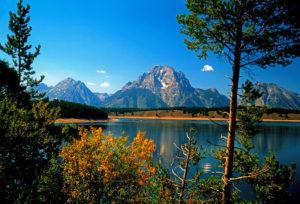
Visits to Wyoming’s Grand Teton and other national parks may take a hit. Photo by Dennis Cox/WorldViews
According to the National Travel and Tourism Office, there was a four percent decline in the number of international visitors to the U.S. during the first six months of 2017 compared to the first six months of 2016.
And according to a recent International Trade Report released by the Commerce Department, spending by international travelers to the U.S. decreased by 3.3 percent through November 2017 compared to November 2016. Total spending by international travelers to the U.S. came to $246 billion, according to figures from the U.S. Travel Association (USTA), a trade group representing travel industry members.
That 3.3 percent decrease translates to a $4.6 billion loss to the U.S. economy as well as 40,000 jobs in tourism-related industries (hotels, restaurants, transportation, stores, tour operators, travel agencies, etc.)
But the ripple effects are felt up and down the economy — many foreign visitors, for instance, come here primarily to shop. U.S. national parks are another foreign favorite, with vibrant tourist economies dependent upon them.
International visitation had been growing for several years before 2017.
The U.S. travel industry currently contributes more than $1.5 trillion to the U.S. GDP annually and supports more than 15 million jobs here in America — jobs that can’t be exported. In 2016, the travel industry generated an $87 billion trade surplus (reducing that year’s overall U.S. trade deficit by 17 percent).
“For our country to have any hope of closing the trade gap, international inbound travel must perform, simple as that,” said Roger Dow, USTA president and CEO.
The Travel Industry Mobilizes
In response to the decline, the USTA is joining with a number of other U.S. industries to launch “Visit U.S.,” a campaign to convince residents of other countries that the U.S. does indeed welcome them to come.

Disneyland welcomes you, as long as you can get here. Photo courtesy of Disneyland
While not specifically blaming the Trump Administration’s anti-immigration broadsides for the decline, Jonathan Grella, the USTA’s executive vice president, said that “a very big portion of the (Visit USA ) coalition’s work is to promote more balanced rhetoric.”
About half of all international visitations to the U.S. comes from Mexico and Canada. Europe and parts of Asia and South America also account for significant portions.
Grella added that they hope to work with the administration to show that “We can have strong national security and still welcome legitimate international visitors…We want to get to the place that the administration says we are closed for terrorism but open for business.”
My Take: Visit U.S. has its work cut out for them. Besides anti-immigration rhetoric and various attempted Muslim travel bans, the administration has made air travel to the U.S. more difficult by adopting strict new security measures in foreign airports, such as banning laptops on some flights.
Where do you draw the line between increased security — or at least so-called attempts at increased security — and “welcoming” foreign visitors? Right now the evidence shows the pendulum has swung away from the welcome mat. And that appears to be a very good reason why the U.S. travel industry is so alarmed.












Leave a Reply